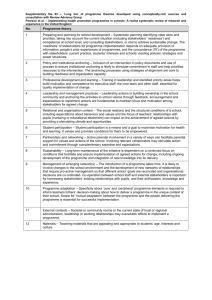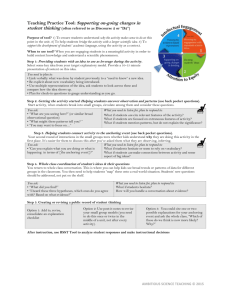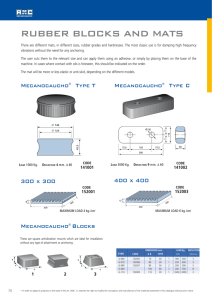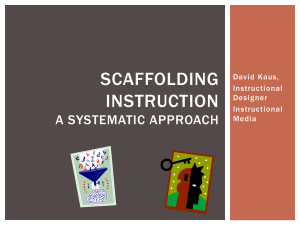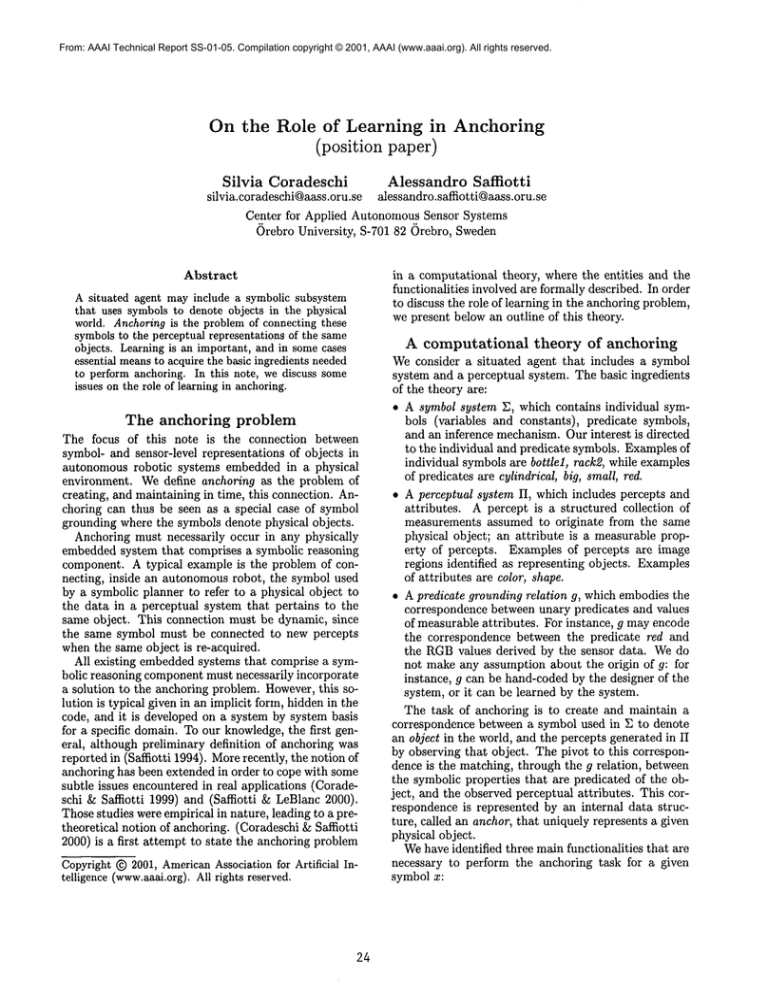
From: AAAI Technical Report SS-01-05. Compilation copyright © 2001, AAAI (www.aaai.org). All rights reserved.
On the Role of Learning in Anchoring
(position paper)
Silvia Coradeschi
Alessandro Saffiotti
silvia.coradeschi@aass.oru.se alessandro.saffiotti@aass.oru.se
Center for Applied Autonomous Sensor Systems
Orebro University, S-701 82 ()rebro, Sweden
Abstract
A situated agent may include a symbolic subsystem
that uses symbols to denote objects in the physical
world. Anchoring is the problem of connecting these
symbolsto the perceptual representations of the same
objects. Learning is an important, and in somecases
essential meansto acquire the basic ingredients needed
to perform anchoring. In this note, we discuss some
issues on the role of learning in anchoring.
The anchoring problem
The focus of this note is the connection between
symbol- and sensor-level representations of objects in
autonomous robotic systems embedded in a physical
environment. Wedefine anchoring as the problem of
creating, and maintaining in time, this connection. Anchoring can thus be seen as a special case of symbol
grounding where the symbols denote physical objects.
Anchoring must necessarily occur in any physically
embedded system that comprises a symbolic reasoning
component. A typical example is the problem of connecting, inside an autonomous robot, the symbol used
by a symbolic planner to refer to a physical object to
the data in a perceptual system that pertains to the
same object. This connection must be dynamic, since
the same symbol must be connected to new percepts
when the same object is re-acquired.
All existing embeddedsystems that comprise a symbolic reasoning componentmust necessarily incorporate
a solution to the anchoring problem. However, this solution is typical given in an implicit form, hidden in the
code, and it is developed on a system by system basis
for a specific domain. To our knowledge, the first general, although preliminary definition of anchoring was
reported in (Saffiotti 1994). Morerecently, the notion
anchoring has been extended in order to cope with some
subtle issues encountered in real applications (Coradeschi & Saffiotti 1999) and (Saffiotti & LeBlanc 2000).
Those studies were empirical in nature, leading to a pretheoretical notion of anchoring. (Coradeschi & Saffiotti
2000) is a first attempt to state the anchoring problem
Copyright © 2001, AmericanAssociation for Artificial
telligence (www.aaai.org).All rights reserved.
In-
in a computational theory, where the entities and the
functionalities involved are formally described. In order
to discuss the role of learning in the anchoring problem,
we present below an outline of this theory.
A computational theory of anchoring
Weconsider a situated agent that includes a symbol
system and a perceptual system. The basic ingredients
of the theory are:
¯ A symbol system E, which contains individual symbols (variables and constants), predicate symbols,
and an inference mechanism. Our interest is directed
to the individual and predicate symbols. Examples of
individual symbols are bottle1, rack2, while examples
of predicates are cylindrical, big, small, red.
¯ A perceptual system H, which includes percepts and
attributes. A percept is a structured collection of
measurements assumed to originate from the same
physical object; an attribute is a measurable property of percepts. Examples of percepts are image
regions identified as representing objects. Examples
of attributes are color, shape.
¯ A predicate grounding relation g, which embodies the
correspondence between unary predicates and values
of measurable attributes. For instance, g may encode
the correspondence between the predicate red and
the RGBvalues derived by the sensor data. Wedo
not make any assumption about the origin of g: for
instance, g can be hand-coded by the designer of the
system, or it can be learned by the system.
The task of anchoring is to create and maintain a
correspondence between a symbol used in E to denote
an object in the world, and the percepts generated in H
by observing that object. The pivot to this correspondence is the matching, through the g relation, between
the symbolic properties that are predicated of the object, and the observed perceptual attributes. This correspondence is represented by an internal data structure, called an anchor, that uniquely represents a given
physical object.
Wehave identified three main functionalities that are
necessary to perform the anchoring task for a given
symbol x:
Find: create an anchor the first time that the object
denoted by x is perceived;
Track: continuously update the anchor while observing the object; and
Reacquire: update the anchor when we need to reacquire the object after sometime that it has not been
observed.
These are detailed in (Coradeschi & Saffiotti 2000),
where we also give examples of their use in two autonomous systems.
The role of learning
Learning can be used to acquire the basic ingredients
needed in the anchoring process. Wefocus here on three
aspects:
¯ learning the predicate grounding relation;
¯ learning a fusion strategy to combine several component properties; and
¯ learning the dynamical behavior of a property.
Below, we illustrate these aspects on examples taken
from an application developed in our laboratory: an
electronic head (Wide, Kalaykov, & Winquist 1999),
which, amongother sensors, is equipped with an artificial nose and tongue. These sensors try to imitate the
corresponding humansenses, and they can differentiate
one substance (typically, food samples) from another.
The task is to endow a mobile platform, equipped with
the electronic head, with the ability to identify objects
on the basis of a symbolic description including visual,
odor, and taste information.
Learning the predicate grounding relation.
The
predicate grounding relation g can be given a priori to
the system and be time invariant. This maynot be adequate in manyapplications; instead, the system should
be able to derive its owngrounding relation or at least
improvethe existing one. For instance, in case of the artificial nose and tongue in the electronic head there is no
well-established numerical model representing the true
function of the sensors. Therefore, the relation between
predicates denoting properties that relate to smell and
taste and the actual measurements acquired from these
sensors has to be learned rather than given a priori.
A preliminary experiment in this sense is reported in
(Loutfi et al. 2001), where an artificial neural network
has been trained to recognize vanilla-, lavender-, and
yogurt-like aromausing an artificial nose.
Learning to combine several properties.
The
task of anchoring is to connect symbols denoting objects to the sensory data derived from the corresponding
physical objects. The focus on individual objects forces
us to deal with the co-occurrence of several properties.
In fact, while classes can be identified by one predicate, a description of a specific object typically needs
25
the combined use of several predicates, like "a small
cup of yogurt with vanilla flavor". The co-occurrence
of several properties can influence the sensor data collected, and the g grounding relation for a combined
property can be more complex than the superposition
of the individual relations for the individual properties. For instance, the recognition of the components
yogurt and vanilla in the odor produced by a yogurt
with vanilla flavor can require not only the grounding
relation for the property of "smelling-like-yogurt" and
"smelling-like-vanilla",
but also a function indicating
how the sensor values tend to change when both substances are present. Such a function would, in most
cases, be difficult to define a priori, and it wouldthen
have to be learned from data.
Learning property dynamics. The anchoring process presupposes two entities, an object to be identified
and an observer. Both entities are located in space
and time. In general, the predicate grounding relation
g may change as the relative spatial relation, or the
time, change. Howto maintain and reacquire the anchor while these changes occur is therefore an essential
issue in anchoring. For example, the data provided by
an odor sensor tend to drift over time, and the sensor can react very differently to the same substance
at different moments in time. In order to be able to
re-identify an object, a model of this drifting must be
used. Since analytical models of the sensor’s drift are
not available, learning seems to be the only viable alternative here.
References
Coradeschi, S., and Saffiotti,
A. 1999. Anchoring
symbols to vision data by fuzzy logic. In Qualitative
and Quantitative Approaches to Reasoning with Uncertainty, LNAI. Berlin, Germany: Springer. 104-115.
Coradeschi, S., and Saffiotti, A. 2000. Anchoring symbols to sensor data: preliminary report. In Proc. of the
AAAI-2000 Conf., 129-135.
Loutfi, A.; Coradeschi, S.; Duckett, T.; and Wide, P.
2001. Odor source identification by grounding linguistic descriptions in an artificial nose. In Proc. of the
SPIE conference on Sensor Fusion.
Saffiotti, A., and LeBlanc. 2000. Active perceptual anchoring of robot behavior in a dynamic environment.
In Proc. of the IEEE Int. Conf. on Robotics and Automation, 3796-3802.
Saffiotti, A. 1994. Pick-up what? In B~ckstrSm, C.,
and Sandewall, E., eds., Current trends in AI Planning. Amsterdam, Netherlands: IOS Press. 266-277.
Wide, P.; Kalaykov, I.; and Winquist, F. 1999. The artificial sensor head: A new approach in determining of
human based quality. In Fusion’99, Second International Conference on Multisource-Multisensor Information, 1144-1149.

